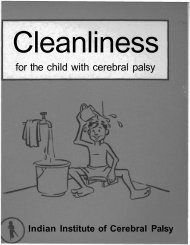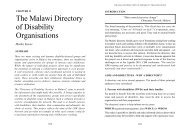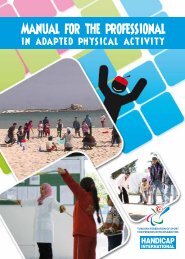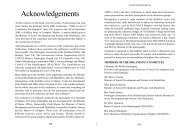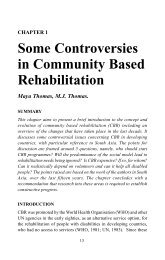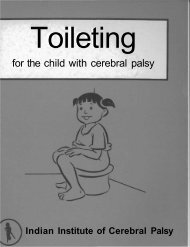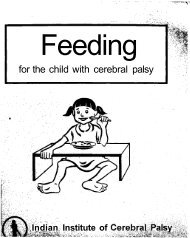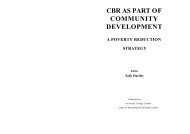Dressing for the child with cerebral palsy - Source
Dressing for the child with cerebral palsy - Source
Dressing for the child with cerebral palsy - Source
You also want an ePaper? Increase the reach of your titles
YUMPU automatically turns print PDFs into web optimized ePapers that Google loves.
<strong>Dressing</strong><br />
<strong>for</strong> <strong>the</strong> <strong>child</strong> <strong>with</strong> <strong>cerebral</strong> <strong>palsy</strong><br />
Indian Institute of Cerebral Palsy
280623661X<br />
DRESSING<br />
<strong>for</strong> <strong>the</strong> <strong>child</strong> <strong>with</strong> <strong>cerebral</strong> <strong>palsy</strong><br />
Ranu Banerjee<br />
Madhuchhanda Kundu<br />
Pratiti Basu Sarkar<br />
Illustrated by<br />
Bela Purohit<br />
Designed by<br />
Himalini Varma<br />
Edited by<br />
Anjana Jha<br />
•TAG
IICP PUBLICATIONS<br />
• EPILEPSY<br />
• SPECIAL FURNITURE<br />
• YOU AND YOUR BABY<br />
• LEARNING AT HOME<br />
• BEHAVIOUR MANAGEMENT<br />
• PLAY FOR THE CHILD WITH CEREBRAL PALSY<br />
• TOILETING FOR THE CHILD WITH CEREBRAL PALSY<br />
• DRESSING FOR THE CHILD WITH CEREBRAL PALSY<br />
• CLEANLINESS FOR THE CHILD WITH CEREBRAL PALSY<br />
• FEEDING FOR THE CHILD WITH CEREBRAL PALSY<br />
• COMMUNICATION FOR THE CHILD WITH CEREBRAL PALSY<br />
• VOCATIONAL TRAINING FOR THE CHILD WITH CEREBRAL PALSY<br />
• PHYSICAL MANAGEMENT FOR THE CHILD WITH CEREBRAL PALSY<br />
© IICP, Calcutta, 1995<br />
Published by:<br />
Indian Institute of Cerebral Palsy<br />
Spastics Society of Eastern India<br />
P-35/1, Taratolla Road<br />
Calcutta 700 088<br />
Phone: 478 3488/478 4177<br />
Laser composed by: Computec Systems, 8 Siddhaswari Road, Calcutta - 700 029.<br />
Printed by: Systems, 6A Ramanath Majumder Street Calcutta - 700 009
Contents<br />
Acknowledgements<br />
Foreword<br />
Introduction 1<br />
Suggestions <strong>for</strong> buying new clo<strong>the</strong>s 2<br />
Teach your <strong>child</strong> to take off his lower garments 3<br />
Teach your <strong>child</strong> to put on his lower garments 8<br />
Teach your <strong>child</strong> to take off his upper garments 1 1<br />
Teach your <strong>child</strong> to put on his upper garments 13<br />
Teach your <strong>child</strong> to button and unbutton 16<br />
Teach your <strong>child</strong> to take off his shoes 18<br />
Teach your <strong>child</strong> to put on his shoes 22<br />
Teach your <strong>child</strong> to take off his socks 25<br />
Teach your <strong>child</strong> to put on his socks 27
Acknowledgements<br />
The authors gratefully acknowledge <strong>the</strong> assistance received from<br />
<strong>the</strong> Rajiv Gandhi Foundation. Special thanks must also be given to all<br />
staff members of <strong>the</strong> Spastics Society of Eastern India and to all parents.<br />
Sponsored by Overseas Development Administration, U.K.
Foreword<br />
Barely three decades ago, <strong>the</strong> majority of <strong>child</strong>ren <strong>with</strong> severe developmental<br />
disabilities like <strong>cerebral</strong> <strong>palsy</strong> were regarded as ineducable. However,<br />
in <strong>the</strong> last few years, <strong>the</strong>re has been a marked increase in <strong>the</strong> awareness of<br />
<strong>cerebral</strong> <strong>palsy</strong> and its implications. The most significant realisation has been <strong>the</strong><br />
fact that <strong>the</strong> education of a <strong>child</strong> <strong>with</strong> a disability is not concerned merely <strong>with</strong> his<br />
intellectual development. The management of a <strong>child</strong> in every sphere of daily<br />
living is of equal importance. Consequently, an interdisciplinary and integrated<br />
approach is essential <strong>for</strong> achieving <strong>the</strong> maximum progress of a <strong>child</strong>.<br />
Parents play a primary role in teaching <strong>the</strong>ir <strong>child</strong> <strong>the</strong> various skills of daily living.<br />
Undoubtedly, <strong>the</strong> parents have <strong>the</strong> best understanding of <strong>the</strong>ir disabled <strong>child</strong>, but<br />
<strong>the</strong>y may often be unaware of <strong>the</strong> best way to go about this enormous task.<br />
The Indian Institute of Cerebral Palsy (IICP) is <strong>the</strong> training and research division of<br />
<strong>the</strong> Spastics Society of Eastern India. The need <strong>for</strong> more in<strong>for</strong>mation on <strong>cerebral</strong><br />
<strong>palsy</strong> has long been felt both by parents and professionals. With this objective in<br />
mind, <strong>the</strong> IICP has planned to produce a series of books and booklets, written by<br />
a team of special educators, <strong>the</strong>rapists and social workers. It is hoped that <strong>the</strong><br />
easy to follow guidelines and illustrations will help parents in <strong>the</strong> daily management<br />
programme of <strong>the</strong>ir <strong>child</strong>.<br />
A disabled <strong>child</strong> has <strong>the</strong> desire as well as <strong>the</strong> ability to learn different skills. With<br />
time, ef<strong>for</strong>t and constant encouragement, he will eventually achieve results to <strong>the</strong><br />
best of his ability.
INTRODUCTION<br />
oung <strong>child</strong>ren learn to dress and undress <strong>the</strong>mselves fairly early in life.<br />
They learn to take off <strong>the</strong>ir socks, shoes and underpants be<strong>for</strong>e <strong>the</strong>y can<br />
take off <strong>the</strong> more complicated clothing like shirts and dresses.<br />
Teaching handicapped <strong>child</strong>ren to take off and put on clo<strong>the</strong>s may take time.<br />
Owing to <strong>the</strong>ir physical or mental handicap, it may be difficult <strong>for</strong> <strong>the</strong>m to learn<br />
<strong>the</strong>se skills on <strong>the</strong>ir own.<br />
If you follow some common rules, you may find it easier to help your <strong>child</strong> to<br />
learn how to dress and undress.<br />
Choose a good position. Decide <strong>the</strong> position in which your <strong>child</strong> is most<br />
steady, <strong>with</strong> or <strong>with</strong>out support. This will make dressing and undressing easier<br />
<strong>for</strong> him. It will also help him to dress or undress himself if he has <strong>the</strong> physical<br />
ability to do so. Some suggestions are given in this booklet which will help you to<br />
choose a good position.<br />
Involve your <strong>child</strong>. Involve your <strong>child</strong> every time you dress or undress him.<br />
Give him clear instructions or show him how to straighten his arms and legs.<br />
This will help him to cooperate <strong>with</strong> you as he grows older.<br />
Start <strong>with</strong> simpler clothing. Always start <strong>with</strong> a simple item of clothing like<br />
a loose shirt <strong>with</strong> front buttons open. He will find it easier to take it off and put it<br />
on. This will make teaching and learning more successful.<br />
Teach undressing first. First teach your <strong>child</strong> to take off his clo<strong>the</strong>s as it is<br />
much easier than learning to put <strong>the</strong>m on.<br />
Start early. Normally parents help <strong>the</strong>ir <strong>child</strong>ren to dress and undress till <strong>the</strong>y<br />
are four or five years old. But if your <strong>child</strong> is handicapped, start teaching him as<br />
early as possible since it will take him more time to learn <strong>the</strong> skill.
SUGGESTIONS FOR BUYING NEW<br />
CLOTHES<br />
Buy or make clo<strong>the</strong>s one size larger. Whenever you get your <strong>child</strong> new<br />
clo<strong>the</strong>s always make sure that <strong>the</strong>y are one size larger.<br />
Shoes must be of <strong>the</strong> correct size, o<strong>the</strong>rwise <strong>the</strong> <strong>child</strong> will find it difficult to<br />
walk.<br />
Have front openings on clo<strong>the</strong>s. It will be easier to unfasten if <strong>the</strong> fasteners<br />
are at <strong>the</strong> front of <strong>the</strong> clo<strong>the</strong>s.<br />
Fasteners should be as simple as possible. Instead of buttons, use<br />
zips on pants and shirts. Use elastic instead of string on pyjamas and buy all<br />
clo<strong>the</strong>s <strong>with</strong> front openings.<br />
Loose T-shirts <strong>with</strong>out any fasteners are easy to wear.<br />
Dress your <strong>child</strong> in clo<strong>the</strong>s that are suitable <strong>for</strong> his age.
TEACH YOUR CHILD TO TAKE OFF HIS<br />
LOWER GARMENTS<br />
Lower garments including long pants, short pants, underwear,<br />
pyjamas, lungi, skirts and salwar.<br />
Start by teaching a <strong>child</strong> to take off shorts or panties and <strong>the</strong>n move on to pants<br />
and salwar.<br />
When you are teaching him to take off his lower garments, make sure that your<br />
<strong>child</strong> is wearing an underwear. This will teach him that he should not undress in<br />
front of anyone and he will develop a sense of privacy. For an older person, it<br />
will be less embarrassing <strong>for</strong> him to take off his pants in front of o<strong>the</strong>rs if he is<br />
wearing underwear.<br />
Once your <strong>child</strong> has learnt to take off o<strong>the</strong>r types of lower garments, he can<br />
practice taking off his undergarments in private.<br />
Practice is very necessary <strong>for</strong> your <strong>child</strong> to improve. So make sure that you give<br />
him <strong>the</strong> opportunity to practise. Choose a time when you are not in a hurry to<br />
dress him so that he can take his time.<br />
In <strong>the</strong> beginning, he will need extra time<br />
to learn.<br />
As suggested earlier, lower garments will<br />
be easier <strong>for</strong> your <strong>child</strong> to take off if <strong>the</strong>y<br />
have elastic on top. For adults, pants<br />
<strong>with</strong> elastic on ei<strong>the</strong>r side and buttons<br />
or zips in front are more appropriate.
Given below are suggestions on how your <strong>child</strong> can take off different garments<br />
and <strong>the</strong> most suitable positions <strong>for</strong> doing so.<br />
If your <strong>child</strong> can stand <strong>with</strong> very little support, <strong>the</strong>n teach her to take off her<br />
shorts or panties by:<br />
Helping her to hook her thumb in <strong>the</strong><br />
top of <strong>the</strong> panties. She can do this by<br />
standing against <strong>the</strong> wall <strong>for</strong> support.<br />
Or she can stand holding a towel rail or<br />
grill. Then teach her to push <strong>the</strong> panties<br />
down to her heels and kick <strong>the</strong>m off her<br />
feet.
If she cannot stand, she can ei<strong>the</strong>r get<br />
into a crawling position or kneel and pull<br />
down <strong>the</strong> panties to <strong>the</strong> knees.<br />
Then she can sit down and pull <strong>the</strong>m off<br />
her feet.<br />
If your <strong>child</strong> cannot kneel or get into a crawling position, <strong>the</strong>n teach him to sit<br />
against <strong>the</strong> wall and take his shorts off by:<br />
First turning to one side and pulling<br />
down <strong>the</strong> shorts on that side and <strong>the</strong>n<br />
turning to <strong>the</strong> o<strong>the</strong>r side and pulling it<br />
down until <strong>the</strong> shorts are below <strong>the</strong><br />
knees.
Then he can bend his knees and pull<br />
<strong>the</strong>m off his feet.<br />
If your <strong>child</strong> cannot sit, <strong>the</strong>n teach her<br />
to lie on <strong>the</strong> floor and take off her panties.<br />
She has to first turn to one side<br />
and pull down <strong>the</strong> panties on that side,<br />
<strong>the</strong>n turn to <strong>the</strong> o<strong>the</strong>r side and again<br />
pull it down on that side, until <strong>the</strong> panties<br />
are below <strong>the</strong> knees.<br />
Then she can push <strong>the</strong>m down to <strong>the</strong><br />
ankle <strong>with</strong> <strong>the</strong> o<strong>the</strong>r leg
and shake <strong>the</strong> panties off her feet.<br />
When your <strong>child</strong> is com<strong>for</strong>table taking off shorts or panties, start teaching how to<br />
take off long pants or salwars in <strong>the</strong> same way.
TEACH YOUR CHILD TO PUT ON HIS<br />
LOWER GARMENTS<br />
Wearing pants is more difficult to learn. Choose a position in which your <strong>child</strong><br />
will find it easier to hold <strong>the</strong> trousers and wear <strong>the</strong>m.<br />
If he is unable to stand <strong>with</strong> support, he<br />
can ei<strong>the</strong>r sit on <strong>the</strong> floor against <strong>the</strong><br />
wall<br />
or on a chair.<br />
Start by teaching him to locate <strong>the</strong> leg<br />
openings through which he will have to<br />
put in his feet. Then teach him how to<br />
hold <strong>the</strong> top band of <strong>the</strong> pants <strong>with</strong> one<br />
or both hands.<br />
8
Let him put one leg at a time into <strong>the</strong><br />
leg openings of <strong>the</strong> pants. If one leg is<br />
more physically affected, he should put<br />
in that leg first.<br />
Once he has both legs in <strong>the</strong> respective<br />
trouser legs, let him pull <strong>the</strong> pants up<br />
above <strong>the</strong> knees.<br />
If he is seated on <strong>the</strong> floor, he can get<br />
into a crawling position and pull <strong>the</strong> pants<br />
up to his waist from his knees.
If he can stand, he can pull up <strong>the</strong> pants<br />
from <strong>the</strong> ankle to his waist in one movement.<br />
If he is lying on <strong>the</strong> floor, he can roll<br />
from one side to <strong>the</strong> o<strong>the</strong>r while he pulls<br />
<strong>the</strong> pants up to <strong>the</strong> waist.<br />
Once <strong>the</strong> pants are up to his waist, he may need your help to fasten <strong>the</strong> buttons.<br />
10
TEACH YOUR CHILD TO TAKE OFF HIS<br />
UPPER GARMENTS<br />
Upper garments include shirts, T-shirts, blouses, sweaters, vests,<br />
dresses and kameez.<br />
When you start teaching your <strong>child</strong> to take off his upper garments make sure<br />
that it:<br />
has a front opening (shirt or a blouse) and<br />
is one size larger.<br />
Put him in a sitting position <strong>for</strong> teaching<br />
him to take off his upper garment. If he<br />
needs support, place him against <strong>the</strong><br />
corner of a room<br />
or make him sit in a corner seat.<br />
11
Teach him to take off <strong>the</strong> shirt or <strong>the</strong> blouse in <strong>the</strong> following way. He will find it<br />
much easier.<br />
Let him hold <strong>the</strong> collar or neck of <strong>the</strong><br />
shirt or dress, ei<strong>the</strong>r <strong>with</strong> both his hands<br />
or <strong>with</strong> his stronger hand<br />
and pull it over his head. Remind him<br />
to bend his head well <strong>for</strong>ward.<br />
He should take it off <strong>the</strong> least affected<br />
arm first<br />
and <strong>the</strong>n shake it off <strong>the</strong> o<strong>the</strong>r arm.
13<br />
TEACH YOUR CHILD TO PUT ON HIS<br />
UPPER GARMENTS<br />
Putting on <strong>the</strong> upper garment is more difficult. The easiest way to teach your<br />
<strong>child</strong> to wear his shirt or blouse is by choosing a garment which is one size larger<br />
and has a front opening.<br />
Keep <strong>the</strong> shirt in front of <strong>the</strong> <strong>child</strong> <strong>with</strong><br />
<strong>the</strong> collar towards him and <strong>the</strong> opening<br />
of <strong>the</strong> shirt on top.<br />
Some <strong>child</strong>ren find it helpful if <strong>the</strong> garment<br />
is placed on a table in front of<br />
<strong>the</strong>m. This makes it easier <strong>for</strong> <strong>the</strong>m to<br />
wear <strong>the</strong> shirt.<br />
Teach him to locate one arm hole and<br />
put in one hand. If your <strong>child</strong> has one<br />
hand which is more affected than <strong>the</strong><br />
o<strong>the</strong>r, teach him to put in <strong>the</strong> more affected<br />
arm first.
Then he can put <strong>the</strong> o<strong>the</strong>r hand in <strong>the</strong><br />
o<strong>the</strong>r arm hole.<br />
He should next pull up <strong>the</strong> sleeves to<br />
<strong>the</strong> elbows.<br />
Once both <strong>the</strong> sleeves are up to <strong>the</strong> elbows, teach him to ga<strong>the</strong>r <strong>the</strong> end of <strong>the</strong><br />
shirt<br />
14
and pull it over his head and down his back.<br />
Remember:<br />
Your <strong>child</strong> must keep his head down and <strong>for</strong>ward while wearing his shirt<br />
as it becomes easier to take <strong>the</strong> shirt over <strong>the</strong> head.<br />
He can <strong>the</strong>n pull <strong>the</strong> front of <strong>the</strong> shirt toge<strong>the</strong>r and put on <strong>the</strong> buttons if<br />
he is able to. (Refer to <strong>the</strong> section 'Teach your <strong>child</strong> to button and unbutton').<br />
He can wear T-shirts, kurtas, vests and sweaters in <strong>the</strong> same way as a<br />
shirt or a dress.<br />
Your <strong>child</strong> will also need to learn to reverse and fold his shirt. You can<br />
teach him to do this after he has learnt to wear and take off his shirt.<br />
Only <strong>the</strong>n can we say that he is totally independent in wearing his shirt.<br />
However, if your <strong>child</strong> is very physically handicapped, he may not be<br />
able to wear a shirt on his own. In this case, teach him to help you when<br />
you dress him. He can do this by:<br />
• sitting still and not struggling<br />
• allowing you to guide his hands when you dress him<br />
• choosing clo<strong>the</strong>s of his choice.<br />
15
TEACH YOUR CHILD TO BUTTON AND<br />
UNBUTTON<br />
Many physically handicapped <strong>child</strong>ren do not have good hand function. So buttoning<br />
and unbuttoning may be difficult <strong>for</strong> <strong>the</strong>m.<br />
To learn how to button, your <strong>child</strong> must have <strong>the</strong> ability to hold small objects<br />
between <strong>the</strong> finger and thumb.<br />
Your <strong>child</strong> will need a lot of practice be<strong>for</strong>e<br />
he learns to use buttons.<br />
It is easier to teach a <strong>child</strong> buttoning<br />
when he is not wearing <strong>the</strong> garment. At<br />
first you can give a garment <strong>with</strong> larger<br />
buttons to practise. Then give him a garment<br />
<strong>with</strong> smaller buttons.<br />
Once he learns to button and unbutton<br />
clo<strong>the</strong>s that he is not wearing, teach<br />
him to button and unbutton clo<strong>the</strong>s that<br />
he is wearing.<br />
16
Always teach him to fasten <strong>the</strong> bottom<br />
button first and gradually move up to<br />
<strong>the</strong> top button.<br />
17
TEACH YOUR CHILD TO TAKE OFF<br />
HIS SHOES<br />
Shoes include sandals, chappals and shoes <strong>with</strong> laces or straps.<br />
Positions suitable <strong>for</strong> taking off and wearing shoes:<br />
• Make sure that your <strong>child</strong> is in a stable position:<br />
• If he can sit <strong>with</strong>out support, <strong>the</strong>n he can.<br />
a) Sit on <strong>the</strong> floor<br />
b) Sit on a chair or a stool.<br />
18
If your <strong>child</strong> needs supports to sit, <strong>the</strong>n he can:<br />
a) sit against <strong>the</strong> wall<br />
b) sit in a corner seat<br />
c) sit on a chair or a wheelchair<br />
<strong>with</strong> arms.<br />
19
The foot from which he is taking off or<br />
putting on <strong>the</strong> shoe can be crossed over<br />
<strong>the</strong> o<strong>the</strong>r leg to help him reach <strong>the</strong><br />
shoe more easily.<br />
Steps <strong>for</strong> taking off shoes:<br />
Teach your <strong>child</strong> to take off his shoes step by step. If he has difficulty in opening<br />
his laces, teach him to do so separately. (Refer to 'Fasteners' on page 26.) Once<br />
you have unfastened <strong>the</strong> laces, start by teaching him to:<br />
Insert his thumb into <strong>the</strong> back<br />
of <strong>the</strong> shoe<br />
2) Push <strong>the</strong> shoe down over<br />
<strong>the</strong> heel<br />
20
3) and take it off his foot completely.<br />
Repeat <strong>the</strong> same steps <strong>with</strong> <strong>the</strong> o<strong>the</strong>r<br />
foot.<br />
When you start teaching him, give him a lot of help initially and gradually reduce<br />
<strong>the</strong> help until he can do it on his own.<br />
Some <strong>child</strong>ren who find it difficult to take off <strong>the</strong>ir shoes in <strong>the</strong> usual way can be<br />
taught to take <strong>the</strong>m off by pushing off <strong>the</strong> shoe <strong>with</strong> <strong>the</strong> o<strong>the</strong>r foot. This is possible<br />
after <strong>the</strong> lace or velcro has been loosened by you. Even if this does not make<br />
<strong>the</strong> <strong>child</strong> totally independent, it gives him a sense of achievement.<br />
21
TEACH YOUR CHILD TO PUT ON<br />
HIS SHOES<br />
Wearing shoes is much more difficult than taking <strong>the</strong>m off. Your <strong>child</strong> will need<br />
help and time to learn to do this.<br />
Start by teaching him:<br />
To identify <strong>the</strong> correct shoe (right shoe<br />
<strong>for</strong> <strong>the</strong> right foot and left shoe <strong>for</strong> <strong>the</strong><br />
left foot.)<br />
If he finds this difficult, you can mark<br />
<strong>the</strong> inside of one shoe <strong>with</strong> a little paint.<br />
Most <strong>child</strong>ren know which hand <strong>the</strong>y eat<br />
<strong>with</strong>. So it will be easier <strong>for</strong> him if you<br />
mark <strong>the</strong> shoe <strong>for</strong> <strong>the</strong> same side as <strong>the</strong><br />
hand he eats <strong>with</strong>.<br />
Next, teach him to locate <strong>the</strong> opening<br />
of <strong>the</strong> shoe and put his toes in.<br />
22
and push his foot into <strong>the</strong> shoe.<br />
Help him to hold <strong>the</strong> back of <strong>the</strong> shoe<br />
firmly. Some shoes have loops which<br />
make <strong>the</strong>m easier to hold.<br />
Then he can pull it up over <strong>the</strong> heel until<br />
<strong>the</strong> foot is completely inside <strong>the</strong> shoe.<br />
23
Children who are severely physically handicapped and have poor hand control,<br />
will not be able to learn this skill.<br />
Fasteners<br />
Shoes are now available <strong>with</strong> velcro fasteners which are easier to handle. If your<br />
<strong>child</strong> has good hand control, he may also be able to tie laces <strong>with</strong> a lot of<br />
practice.<br />
Remember<br />
Shoes are worn to give extra support and should always be tied firmly.
TEACH YOUR CHILD TO TAKE OFF HIS<br />
SOCKS<br />
Positions suitable <strong>for</strong> taking off and wearing socks:<br />
Refer to <strong>the</strong> earlier section on 'Teach your <strong>child</strong> to take off his shoes'.<br />
Steps <strong>for</strong> taking off socks:<br />
Start teaching a <strong>child</strong> to take off his socks by practising <strong>with</strong> a pair that is large<br />
<strong>for</strong> him.<br />
1) At first, take off <strong>the</strong> sock up to <strong>the</strong><br />
toe and teach your <strong>child</strong> to pull it<br />
off.<br />
2) Next take off <strong>the</strong> sock up to <strong>the</strong><br />
heel and let your <strong>child</strong> pull it off<br />
from <strong>the</strong>re.<br />
25
3) Once he has learnt to do <strong>the</strong> earlier<br />
steps, take <strong>the</strong> sock down to<br />
above <strong>the</strong> heel and teach him to<br />
pull it over <strong>the</strong> heel off <strong>the</strong> foot.<br />
4) Finally he should learn to take<br />
off <strong>the</strong> sock entirely on his own.<br />
The advantage of teaching in this manner is that at each step <strong>the</strong> <strong>child</strong> will<br />
complete <strong>the</strong> task of taking off his socks and will feel a sense of achievement.<br />
At first give him all <strong>the</strong> help he requires but gradually reduce your help until he<br />
can do it on his own.<br />
The socks can be gradually changed to <strong>the</strong> correct size. At first he will find it<br />
difficult to take off <strong>the</strong> socks. But <strong>with</strong> a lot of practice he will soon learn.<br />
26
TEACH YOUR CHILD TO PUT ON HIS<br />
SOCKS<br />
Putting on socks can be difficult <strong>for</strong> a <strong>child</strong>. But it will be easier <strong>for</strong> him if you:<br />
Buy cotton socks which have different<br />
coloured heels and toes.<br />
Teach him to wear <strong>the</strong> socks in <strong>the</strong> same way as he learnt to take <strong>the</strong>m off.<br />
1) Put on his sock over <strong>the</strong> heel and<br />
teach him to pull it up to <strong>the</strong> calf.<br />
11
2) Next put on <strong>the</strong> sock up to <strong>the</strong><br />
heel and he can pull it up over<br />
<strong>the</strong> heel and up to <strong>the</strong> calf.<br />
3) Finally teach him to locate <strong>the</strong><br />
opening of <strong>the</strong> sock and put in<br />
his toes<br />
and pull it over <strong>the</strong> heel up to <strong>the</strong> calf.<br />
In this way he will learn to wear <strong>the</strong> sock step by step. Remember that each step<br />
may take many days of practice and training be<strong>for</strong>e he can move on to <strong>the</strong> next<br />
step.<br />
Children who have difficulty in holding things <strong>with</strong> <strong>the</strong>ir hands may not be able<br />
to take off or put on <strong>the</strong>ir socks on <strong>the</strong>ir own.<br />
But you can teach your <strong>child</strong> to help you to take off his socks or put <strong>the</strong>m on <strong>for</strong><br />
him by keeping his legs in place and not moving.<br />
28



